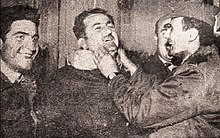March 8th Revolution

The March 8 Revolution ( Arabic ثورة الثامن من آذار, DMG ṯawrat aṯ-ṯāmin min āḏār ), also known as the March Revolution of 1963 , was a successful military coup by the Syrian regional command of the Arab Socialist Ba'ath Party . The government of President Nazem Koudsi and Prime Minister Chaled Alazem of the People's Party were overthrown.
In the coup, in which the Syrian army , the navy and the air force also took part, over 800 people died and a further 20 people were executed . The planning and conspiracy of the coup was inspired by the Iraqi Baath Party 's military coup .
Planning and preparation

The coup was planned by the Baath Party's military committee rather than its civilian leadership. The party chairman Michel Aflak , however, agreed to the plan. The leading members of the military committee, even after the seizure of power, were the Druze Muhammad Umran and the two Alawites Salah Jadid and Hafiz al-Assad . Other members were Louai al-Atassi and Amin al-Hafiz . The committee received support from two Nasserists , Rashid al-Qutayni and Muhammad al-Sufi , and the independent Ziad al-Hariri .
The coup was originally scheduled for March 7, but was postponed for a day after the government of the then Syrian Republic discovered that conspirators were planning a meeting.
Results and further development
During the revolution it was possible to bring Baathists and Nasserists together and to appoint the "old Baathists" as government leaders. The National Council of Revolutionary Command took on the role of legislature, and Salah Eddine Bitar was assigned the role of head of a government of national unity . The Ba'ath participated in this government, along with the Arab Nationalist Movement (Nasserists), the Arab United Front and the Unified Socialist Organization (ex-Ba'athists). As a compromise between Baathists and Nasserists, Louai al-Atassi became chairman of a National Command Council of the Revolution and thus de facto head of state.
The state of emergency imposed during the March 8 revolution remained in force until the 2011 Syrian civil war .
The Ba'ath later proceeded to consolidate its power in the new regime and in April of the same year eliminated the Nasserist officers. The turmoil that followed led to the overthrow of Bitar's government and a failed coup by the Nasserists under Yassem Alwan in July, during which the Ba'ath further expanded power.
See also
literature
- Hinnebusch, Raymond: Syria: Revolution from Above . 1st edition. Routledge , 2001, ISBN 978-0-415-26779-3 .
- Hopwood, Derek: Syria 1945–1986: Politics and Society . Routledge, 1988, ISBN 978-0-04-445046-7 .
- Seale, Patrick: Asad of Syria: The Struggle for the Middle East . University of California Press , 1990, ISBN 978-0-520-06976-3 .